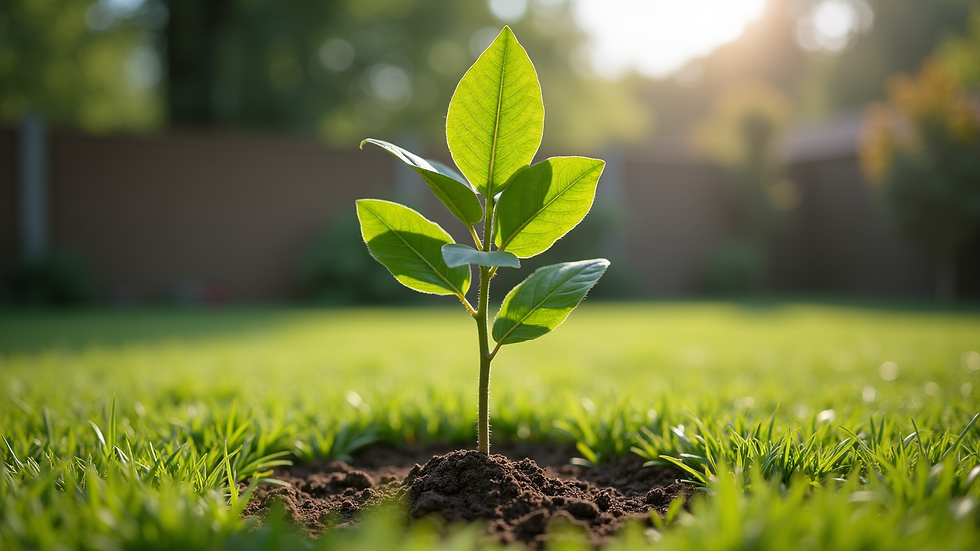Smart Practices for Young Tree Establishment
- Writer
- Sep 23
- 4 min read
Planting a young tree is exciting. You imagine its future shade, beauty, and the value it adds to your home. But do you know what it takes to help that tree thrive? Young trees need more than just water and sunlight. They require smart care from the start. If you want your tree to grow strong and healthy, you must act wisely now. Let’s explore how to give your young tree the best chance to flourish.
Why Caring for Young Trees Matters
Young trees are vulnerable. Their roots are small, their trunks are thin, and their bark is delicate. Without proper care, they can suffer from drought, pests, or even poor planting techniques. Have you ever seen a tree that looks healthy but slowly weakens over time? That’s often because of hidden problems like deep planting or compacted soil.
Caring for young trees means more than watering. It means understanding their needs and protecting them from common threats. When you care well for your young tree, you set it up for decades of growth. You prevent slow-motion failure, a silent killer of many trees in urban areas.
Here’s what you can do:
Plant at the right depth: Avoid planting too deep. The root flare should be visible above the soil.
Water deeply and regularly: Young trees need consistent moisture, especially in dry spells.
Mulch properly: Use organic mulch to retain moisture and regulate soil temperature.
Protect from damage: Keep lawnmowers and weed trimmers away from the trunk.
Stake only if necessary: Too much staking can weaken the tree.
These steps might seem simple, but they make a huge difference.

Essential Tips for Caring for Young Trees
You want your tree to grow tall and strong, right? Then you need to focus on the basics and do them well. Here’s a checklist to keep your young tree healthy:
1. Choose the Right Location
Before planting, think about space. Will the tree have room to grow? Avoid planting too close to buildings, sidewalks, or underground utilities. Trees need space for roots and branches.
2. Plant Correctly
Dig a hole twice as wide as the root ball but no deeper. Place the tree so the root flare is just above ground level. Backfill with native soil, not amended soil, to encourage roots to spread.
3. Water Wisely
Water deeply once or twice a week. Shallow watering encourages roots to stay near the surface, making the tree less stable. Use a slow drip or soak method to reach deep roots.
4. Mulch Right
Apply 2-4 inches of mulch around the base, but keep it a few inches away from the trunk. Mulch helps retain moisture, suppress weeds, and protect roots from temperature swings.
5. Monitor and Protect
Check your tree regularly for signs of stress or pests. Use tree guards if animals or equipment might damage the bark. Remove any stakes after one year to allow natural movement.
By following these tips, you build a strong foundation for your tree’s future.

How much does a young tree cost?
You might wonder, how much should you expect to invest in a young tree? The cost varies depending on species, size, and where you buy it. On average, a young tree suitable for a home landscape can cost between $50 and $300.
Small saplings (1-2 feet tall): $50-$100
Medium-sized trees (3-6 feet tall): $100-$200
Larger young trees (6+ feet tall): $200-$300 or more
Remember, the initial cost is just part of the investment. You also need to budget for planting supplies, mulch, watering tools, and possibly professional help. Proper care during the first few years can save you money by preventing costly tree health problems later.
If you want expert help with young tree establishment, professionals can ensure your tree is planted correctly and cared for from day one.

Avoiding Common Mistakes in Young Tree Care
Many homeowners unknowingly harm their young trees. Are you making any of these mistakes?
Planting too deep: This suffocates roots and leads to rot.
Overwatering or underwatering: Both stress the tree and stunt growth.
Using too much mulch or piling it against the trunk: This invites pests and disease.
Ignoring staking needs: Either staking too much or not at all can cause weak trunks.
Neglecting root health: Compacted soil or damaged roots limit nutrient uptake.
How can you avoid these pitfalls? Stay informed and observe your tree closely. If you see yellowing leaves, wilting, or slow growth, act quickly. Sometimes, a simple adjustment in watering or mulch can turn things around.
Long-Term Care: Setting Your Tree Up for Success
Young tree care doesn’t end after the first year. Trees grow slowly and need ongoing attention. Here’s how to support your tree as it matures:
Prune carefully: Remove dead or crossing branches to promote healthy structure.
Fertilize sparingly: Use slow-release fertilizers if soil tests show deficiencies.
Watch for pests and diseases: Early detection helps prevent serious damage.
Maintain mulch and watering routines: Adjust as the tree grows and seasons change.
Protect from construction or landscaping damage: Roots can be easily injured.
By staying proactive, you help your tree avoid the slow-motion failure that plagues many urban trees. Your efforts pay off with a beautiful, resilient tree that enhances your property for decades.
Taking care of young trees is a rewarding challenge. With the right knowledge and actions, you can watch your tree grow from a fragile sapling into a majestic part of your landscape. Don’t wait until problems appear. Start smart, stay consistent, and enjoy the benefits of a thriving tree for years to come. If you want expert guidance, consider reaching out for professional young tree establishment services to get it right the first time. Your tree—and your home—will thank you.


